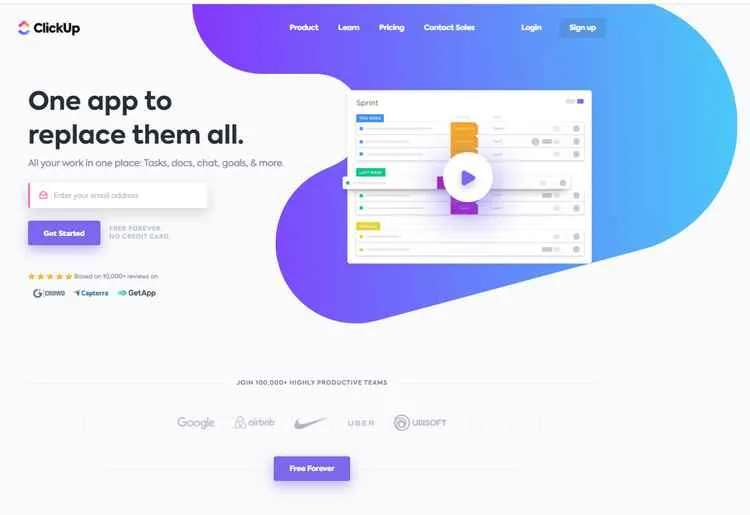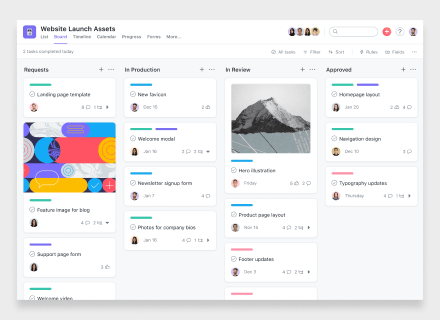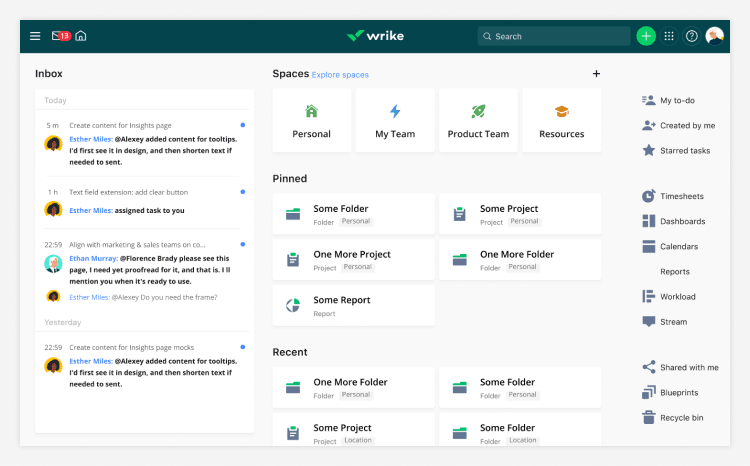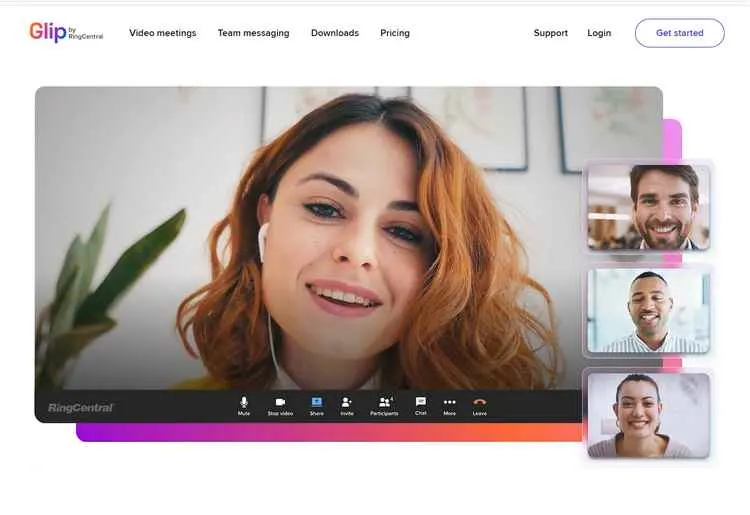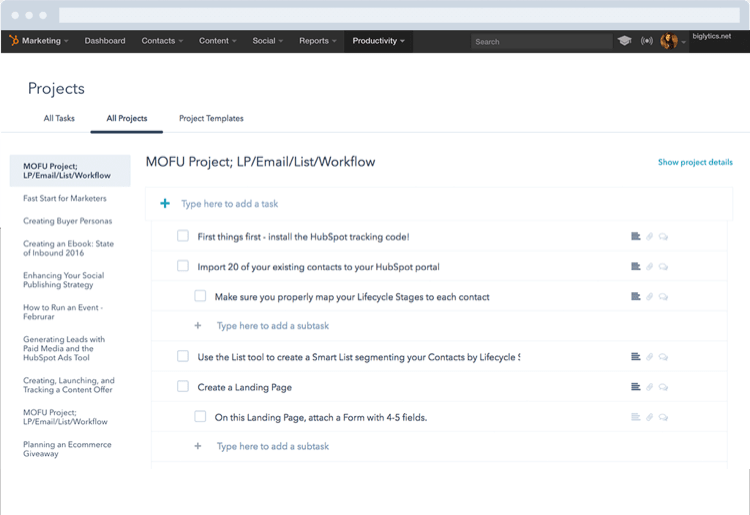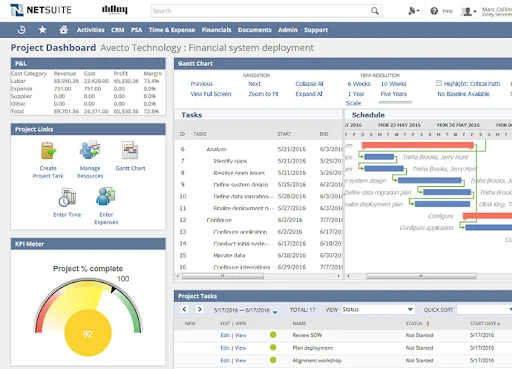Top 10 Best Project Management Software & Tools to Organize Your Team

Project management software is the Rolodex for businesses. It’s the glue that holds everything together, the infrastructure that keeps everything organized, and the software that maintains structure and sanity in a busy, competitive, and ever-changing world that’s high on demand and short on time. Project management software helps businesses manage time, resources, budget, scope, and teams efficiently. So, you maximize your output and your profit. In short, it’s good stuff.
Here’s our best project management software of 2022 to help you stay organized, and to help your teams collaborate better, even if you’re working remotely during the COVID-19 pandemic.
Best Project Management Tools
u
u
u
u
u
#1
- Price:- From $24 per month
- Storage size– 5GB-unlimited
- Free trial-14-day (Pro plan)
- Team collaboration tools- Chat, file-sharing, progress tracking
- Views- Kanban, Gantt, timeline, calendar, map, chart
#2
- Price:- $7/user/month
- Storage size– 5GB – 250GB
- Free trial– Yes
- Team collaboration tools- Comments, automations, file sharing, @ mentions
- Views- Grid, Kanban, Gantt, calendar
#3
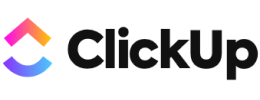
- Price:- From $5/user/month
- Storage size– Up to 100MB on free plan, unlimited on paid plans
- Free trial– Yes
- Team collaboration tools- Real-time collaboration, powerful commenting, chat view
- Views- Kanban, task list, Gantt, and more
#4

- Price:- Free to $30.49/user/month
- Storage size– Unlimited
- Free trial– Free plan
- Team collaboration tools- File sharing, mail and messaging integration
- Views- Lists, Kanban boards, timelines
#5

- Price:- From $9.80 per user per month
- Storage size– 2GB
- Free trial– 14 days
- Team collaboration tools- Live editor, @mentions, file sharing
- Views- List, boards, Gantt, Stream
#6

- Price:- From $19.99/user/mo
- Storage size– No limit
- Free trial– 30-day
- Team collaboration tools- Yes
- Views- N/A
#7

- Price:- From $45/mo
- Storage size– Unlimited
- Free trial-14-day
- Team collaboration tools- Email, live chat, HubSpot Projects
- Views- N/A
#8

- Price:- From $4.50/mo
- Storage size– N/A
- Free trial-30-day
- Team collaboration tools-Discussion area, file-sharing
- Views- N/A
#9

- Price:- By quote only
- Storage size– No limits
- Free trial– Free product tour
- Team collaboration tools-Real time interactive charting and chat and comment functionalities
- Views– Dashboard view, visual project mode,and more
1
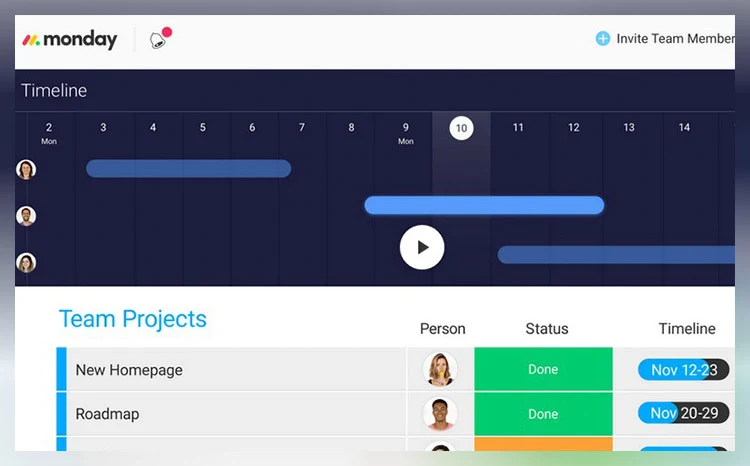
Our reviews come from verified users–just like you!
The star ratings are based on the overall rating of each brand. Some reviews are provided via third party suppliers. We encourage you to write a review of your experiences with these brands.
- Price-From $24
- Team collaboration tools - Chat, file-sharing, progress tracking
- Free trial-14-day (Pro plan)
monday.com Work OS is a flexible platform you can use to manage all of your team’s projects, processes and workflows in one place. While the platform is intuitive and visually stunning, it’s robust enough for large organizations to manage all of their work across departments. To use monday.com, simply choose one of the 200+ ready-made templates to start within minutes, and fully customize it with 20+ editable columns and dozens of no-code automations. Then import your data from spreadsheets and integrate all of the tools you’re already using for seamless onboarding. With high-level overviews and automatically updating dashboards created uniquely for any team, everyone can see what tasks are still on the table, where they’re holding in a project timeline, approaching deadlines, etc. Team members can also share files, add comments, and communicate directly within the task manager for ultimate transparency and collaboration. You can test drive monday.com and experience the difference.
Prons
- Multiple views to choose from
- Task assignment and management
- Track progress with detailed, visual reports
Cons
- The Basic Plan is limited
- Higher tiers are a bit pricey
2
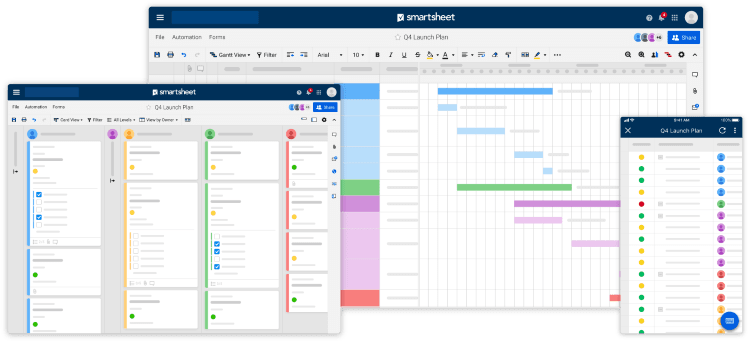
- Price-From $24
- Team collaboration tools - Chat, file-sharing, progress tracking
- Free trial-14-day (Pro plan)
Smartsheet is the enterprise platform for dynamic work. A leading cloud-based platform for work management, Smartsheet empowers organizations and teams to dynamically plan, execute, and report on work at scale, resulting in more efficient processes, innovative solutions, and better business outcomes.
Today, over 90% of Fortune 100 companies and over 75% of Fortune 500 companies rely on the secure, scalable Smartsheet platform to connect the entire enterprise. The single Smartsheet platform gives people a solution flexible enough to adapt to the changing needs of dynamic work across a broad array of departments and use cases.
Prons
- Grid, Kanban, Gantt, reports, and dashboards
- Customizable templates
- Automated update and approval requests
Cons
- Steep learning curve
- Less collaboration tools than competition
3
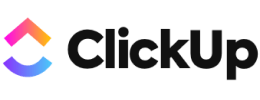
ClickUp
- Price-From $5/user/month
- Team collaboration tools - Real-time collaboration, powerful commenting, chat view
- Free trial-Yes
ClickUp is a mature project and task management tool that allows users to visualize project statuses in a wide variety of ways including Gantt charts, mind maps, and Kanban boards.
It also boasts a wide integration library including tools that work with Slack, GitLab, GitHub, and Webhooks. The latter allows development teams to integrate it with an enormous variety of softwares.
Prons
- Wide visualization options
- Extensive integration library
- Unlimited project storage on paid plans
Cons
- Storage limit on free tier
- Board limit on free tier
4

asana
- Price-Free to $30.49/user/month
- Team collaboration tools - File sharing, mail and messaging integration
- Free trial-Yes
Asana is a project management software designed to help keep your business on track. The software makes it easy to break down projects into tasks and then assign those tasks to individual team members. Asana offers lists, kanban boards, and Gantt charts, which together, give employees and managers both a macro and micro view of the work that needs to be done.
Asana especially stands out for its flexibility and collaboration tools. Employees can comment on tasks and share updates, and Asana has built-in tools for automating routine work. Plus, it integrates with more than 100 popular business software platforms, including messaging apps like Slack and Microsoft Teams.
Prons
- Multiple ways to view your projects and tasks
- Powerful free plan
- Fully integrates with your accounting software
Cons
- No resource management or budgeting tools
- Pricey for larger teams
5

Wrike
- Price-From $9.80
- Team collaboration tools -Live editor, @mentions, file sharing
- Free Trial-14 days
Wrike makes it easy to manage your projects, from inception and planning, to reporting and analysis. Live editing and file management also make it easy to upload documents to a task and edit them directly in Wrike. Wrike also features plenty of collaboration tools and can be integrated with Gmail, Slack and Outlook.
Prons
- Extremely affordable and pro plans
- Advanced integrations
- Impressive features even in lower level plans
Cons
- Not ideal for small businesses
- Gets pricey as you go up in tiers
6

Ring Central
- Price-From $19.99/user/mo
- Team collaboration tools -Yes
- Free Trial-30-day
Glip from RingCentral puts a lot of other project management software options to shame. Why? For one reason, it offers a free version that is better than most of the competition’s paid-for accounts. With a free account from Glip, you’ll get unlimited chat, storage, guest users, integrations, and teams. You’ll also receive notifications about tasks, projects, and messages, a totally customizable workspace, file annotations, and a whole slew of third-party integrations so that you can bring all your favorite tools along for the ride.
But it gets better. Glip also has a paid-for account. For the laughably low price of $11.99 a month per user, you get all of the features mentioned above plus more. Things like 500 minutes a month per user for shared video chatting, 24/7 live support, and data retention policies come along with this “major” upgrade. Yes, Glip has definitely started making the competition reconsider their own paltry offerings. And it should make you reconsider paying any more for quality project management software. Learn more about RingCentral’s outstanding PM software Glip.
Prons
- Cloud data retention
- No time limit on Pro meetings
- Carrier class infrastructure
Cons
- No Linux app
- Some users report hang up lags
7

hubspot
- Price-From $45/mo
- Team collaboration tools -Email, live chat, HubSpot Projects
- Free Trial-14-day
In addition to its well-known CRM software, HubSpot offers project management that draws from the same philosophy of ease and functionality. Its organizational features excel at uniting managers and teams with calendars, emails, and spreadsheets under the banner of one agile app, and collaboration tools that keep all communications anchored in one place. Unique to HubSpot’s project management app are its pre-made to-do lists and customizable templates, which can be saved and reused for similar projects in the future. The tool rounds nicely out with marketing automation features, in-depth analytics, and easy-to-use lead management.
Prons
- Widely recognized leader in marketing software
- Customizable templates can be saved for similar projects
- Agile and easy to use
Cons
- Paid version costs more than other software
- Steeper learning curve

FreshBook
- Price-From $4.50/mo
- Team collaboration tools -Discussion area, file-sharing
- Free Trial-30-day
Freshbooks is an invoicing and time-management tool that’s ideal for freelancers and smaller teams. While it lacks some of the features of other project management tools, such as multiple chart views and desktop apps, the cloud-based tool puts its focus on helping freelancers chart their work, organize clients, and stay on top of payment and invoicing needs. To that end, it’s strongest tools, such as customizable invoices, automated payment nudges, and automatic tax calculations, may not speak to larger teams but make Freshbooks a unique and ideal option for freelancers looking to manage all the moving parts of their business.
Prons
- Strong invoicing system
- Automated payment nudges
- Great for freelancers
Cons
- Limited team collaboration
- No board-based views

Oracle NetSuite
- Price-By quote only
- Team collaboration tools -Real time interactive charting and chat and comment functionalities
- Free Trial-Free product tour
Developed by Oracle, Netsuite is an enterprise-grade CRM tool that will let you seamlessly connect to data sources. You’ll also be able to take advantage of the many features available from Netsuite, including sales forecasting, commission tracking, and detailed task tracking.
Prons
- Enterprise grade tools
- Gantt charting
- Common milestone types
Cons
- Not suitable for small business
- Custom pricing only
Frequently Asked Questions
software and it can be accessed from your desktop or mobile devices.
Monday is a visual-based project management tool that because of its color-coded design is exceptionally easy to use. There is a small learning curve however, which is true with most project management software. Hubspot is also known for its accessibility as is especially popular with those new to project management software.
Smartsheet and Project Manager are two great project management tools that offer Gantt chart viewing. Others include Proggio, Paymo, and Zoho Projects.
Key Features To Look For
Project management features will vary in importance depending on your business’s size, brand personality, and team members. In general, though, there are some features that you just don’t want to do without. Some of the really important ones include:
- Risk projection and management
A crucial component to any project planning software, risk management keeps you out of hot water.
- Resource management and allocation
This important feature ensures that you aren’t going over budget and that you have assigned the right resources to the right tasks/teams/projects etc.
- Dependencies and milestones
Dependencies ensure that your team is staying on track. Milestones help keep people motivated. They’re both important for workflow and sticking to a deadline. This also includes critical path analysis.
- Multiple views
You’ll want the choice between different views such as Kanban, Gantt, timeline, etc. because different tasks, personalities, and projects will require a different view.
- Third-party integrations
This will allow you to cut down on time switching between apps for multiple tasks such as updating your timesheet, sending a text message, transferring a file, or checking your email.
- Task management
Probably the most important feature of all, task management allows you to assign tasks, keep tabs on them, track changes, and more. This is really the heart of any good project management software.
- Team collaboration
The second most important feature, team collaboration tools can help save you countless hours of work through simple communication. Things like file sharing, group chat, @mentions, and more will keep everyone on the same page and ensure a smoother, faster turnaround.
- Customizable everything
The more you can customize, the better. From dashboards to fields and even more so workflows, customization allows you to maximize the efficiency of your team and of the project management software altogether.
- Mobile accessibility
Because most teams are not office-bound these days, you need a product that will easily come with you wherever you go. Mobile-friendly or native apps are a must-have today.
Other features to look for may include agile workflow system and time tracking features.
What are the Differences in Project Management Software?
There are countless differences between the various project management software options available today. From price to feature sets, usability, and more, you’ve got something for everyone. One of the biggest differences you’ll find, though, is between the basic project management software options and the more comprehensive ones.
The first type is a simple tool that has limited functionality but does the job well enough. It’s clean, easy to use, and might be the perfect solution for an SMB or startup to get their head around a tough project that needs organizing. These usually have some basic features like integration and team collaboration.
More comprehensive software will include a lot more features and functionality. These might have resource management, finance management, and accounting software included. Comprehensive tools will also give you more sophisticated and powerful options. Such precision will come with a bigger price tag and is usually better for larger businesses.
Why do I need project management software?
Project management software is a force multiplier. It helps you organize your time and resource management, create reports about business and employee performance, and get a better idea of what’s working and what isn’t. Project management software can also make team collaboration easier and more seamless than ever before.
Is it easy to use?
Project management software is designed to be easy to use, after all, that’s sort of the whole point of systems that are supposed to make your work easier. These programs shouldn’t take long for employees to master and should have a straightforward, intuitive interface for carrying out tasks and communicating with teammates.
How steep is the learning curve?
Project management software platforms tend to have a wide range of capabilities, and if you were looking to master every facet, it could take you some time. For most employees, though, the basic tasks they would need to carry out shouldn’t take long to master at all and won’t require any previous tech know-how.
How much will it cost me?
That’s a tricky question to answer. How much your project management software will cost you at the end of the day depends on how many users you want and what type of features you’re looking for. A basic option like Glip can cost you nothing at all. And if you’re an SMB working out of your garage, this is a great option.
Alternatively, enterprise-level plans will run you hundreds of dollars a month. But if you are big enough, and your budget can afford it, these plans will deliver the most in terms of functionality and style. Look for a plan that fits your budget and still offers a nice set of features.
Is my data safe with a PM software?
Considering the fact that it’s handling your most sensitive and private business information, project management software needs to have top security. That’s why you need to go with a trusted name that also has plenty of security measures built into its business profile to safeguard your data. Monday.com, for example, is ISO certified, GDPR compliant, HIPAA compliant, and holds an EU-US privacy shield, among other protective measures.
It’s also a good idea to safeguard your information by using leveled user security protection and passwords, features that top-quality project management software will have.







